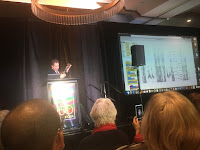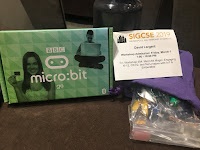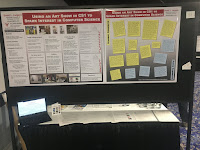 I attended my first SIGCSE Technical Symposium as a faculty member last week. I attended one other time, way back in 2010, when I was a graduate
student. At that time, I delivered a Student Research Competition talk
and poster about my thesis work related to small group development as it relates to software development teams. I also served as a student volunteer for the symposium. It was a great experience, but I only experienced part of the full event. This year, attending as a faculty member, I was able to experience the full gamut that SIGCSE has to offer, including being both giver and receiver.
I attended my first SIGCSE Technical Symposium as a faculty member last week. I attended one other time, way back in 2010, when I was a graduate
student. At that time, I delivered a Student Research Competition talk
and poster about my thesis work related to small group development as it relates to software development teams. I also served as a student volunteer for the symposium. It was a great experience, but I only experienced part of the full event. This year, attending as a faculty member, I was able to experience the full gamut that SIGCSE has to offer, including being both giver and receiver.
One of the symposium co-chairs is a two-time graduate of Ball State University's Department of Computer Science. Manuel Pérez-Quiñones now serves as the Associate Dean of the College of Computing and Informatics at the University of North Carolina at Charlotte. I first met him when he returned to the Ball State campus a few years ago to deliver a keynote at a diversity research symposium. It was good to greet him again and deliver a “hello” from BSU.
 |
| Dave, Christian, and James |
I enjoyed the keynote presentations. Marie desJardins (Simmons University in Boston) focused on inclusion in computing, ultimately discussing these “Five Pernicious Myths.”
“He was born to be a computer scientist.”
“Computer scientists are… {insert stereotype here}.”
“Anybody can be a computer scientist—girls just don’t want to.”
“It’s a joke—don’t you have a sense of humor?”
“’Diversity programs’ are just political correctness.”
Check out her presentation slides for a wealth of information and resources.
Gloria Townsend (DePauw University) provided a top-ten list that identified the most effective strategies used at DePauw to recently award 47% of their computer science undergraduate degrees to women. Her list included these items, many focusing on women:
10. Celebrations
9. Networking
8. ACW-W chapter
7. Mentoring
6. Role modeling
5. Outreach
4. Content preview
3. Social activities
2. Female CS1 teachers
1. Encouragement
 |
| Mark playing a ukulele |
Mark Guzdial (University of Michigan) delivered a keynote in which he posited that “teaching programming as a way to express ideas, communicate with others, and understand our world is one of the oldest goals for computing education,” and that “Computer Science was invented to be a tool for learning everything else.” His justification can be found in his presentation slides. At the end, he gave us a call to action to find our allies and grow the community, and to invent, mutate, and evolve. His blog is well worth your time, so take a look.
I first met Mark when he chaired my paper session at ICER 2010 in Aarhus, Denmark. This was my first international academic conference. To put things into perspective, I started my first semester of full-time teaching at a university a few days after the conference. I presented my thesis work related to small group development as it relates to software development teams. After collecting five years worth of data, I turned it into an ACM TOCE journal article. If I recall correctly, my table-mates for dinner that evening were Mark, Beth Simon, and someone from NSF, whose name I have long since forgotten. Talk about being out of my element! But they were all very gracious, and it was a great dinner. Beth and I talked about peer instruction and the use of clickers. I started using clickers that fall, but it was three more years before peer instruction made its way into my classrooms.
I first met Mark when he chaired my paper session at ICER 2010 in Aarhus, Denmark. This was my first international academic conference. To put things into perspective, I started my first semester of full-time teaching at a university a few days after the conference. I presented my thesis work related to small group development as it relates to software development teams. After collecting five years worth of data, I turned it into an ACM TOCE journal article. If I recall correctly, my table-mates for dinner that evening were Mark, Beth Simon, and someone from NSF, whose name I have long since forgotten. Talk about being out of my element! But they were all very gracious, and it was a great dinner. Beth and I talked about peer instruction and the use of clickers. I started using clickers that fall, but it was three more years before peer instruction made its way into my classrooms.
 I attended a variety of paper presentations and a workshop. Since this post is already lengthy, and I have one more big thing I want to share, I’m going to skip the details of the papers and the workshop. If you really want to know, ask me about them.
I attended a variety of paper presentations and a workshop. Since this post is already lengthy, and I have one more big thing I want to share, I’m going to skip the details of the papers and the workshop. If you really want to know, ask me about them.
But wait; there's more...
My two presentations served as bookends for my symposium experience; I started with the specs grading workshop and ended Saturday morning by presenting a poster about the CS1 Art Show I’ve been coordinating for six years. For much of that time I anecdotally knew the show had a generally positive impact on our students, the department, and how others view us. This past summer I started collecting data, and now can more formally make that claim, with data to back it up. My poster presented some of that data and described the details and logistics of producing the art show. Included were student and judge comments.
 I talked with a dozen or more people during my two-hour poster presentation who seemed genuinely interested in doing something similar with their own course. I remember one person exclaiming “This is exactly what I’ve been looking for!” All these interactions provided a wonderful affirmation that I did something good. But there were three visitors, in particular, who but me over the top, providing a great way to end my symposium experience.
I talked with a dozen or more people during my two-hour poster presentation who seemed genuinely interested in doing something similar with their own course. I remember one person exclaiming “This is exactly what I’ve been looking for!” All these interactions provided a wonderful affirmation that I did something good. But there were three visitors, in particular, who but me over the top, providing a great way to end my symposium experience.In the fall of 2013 we started using the media computation textbook authored by Mark Guzdial and Barb Ericson. That same semester, I was inspired to hold an art show based on collages our CS1 students were creating for one of their course projects. The idea originated from an article by Beth Simon and Leo Porter about a similar event they produced. I took their idea and modified it to work in our environment.
Fast forward to a few days ago. I wondered if Mark, Barb, Beth, or Leo (all of whom I knew were present at the symposium) might be interested in my research about the art show, so I sent them all a message letting them know I was presenting my poster Saturday morning. They all expressed interest, indicating that they’d try to drop by my poster session, but some of them indicated they had busy schedules. As such, I wasn’t holding my breath.
To my delight Mark arrived and talked with me for 10-15 minutes. While reviewing the presented data, he seemed excited about how learner-centered and engaging the whole art show process is. After he left, Barb arrived a few minutes later. I was talking with another individual at the time, but she very patiently waited until they were done, spending time reviewing my poster. She also provided lots of encouragement about the art show project.
| Image by rawpixel.com |
The inspired (me), had just inspired the inspirer!


